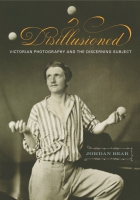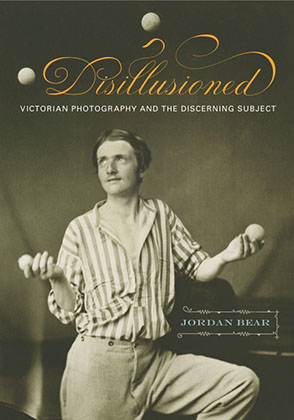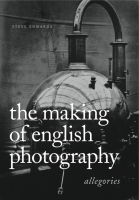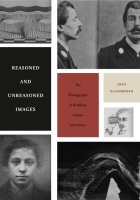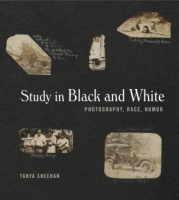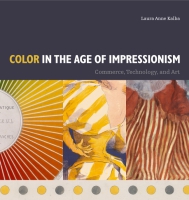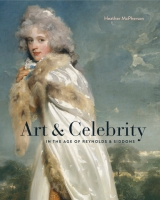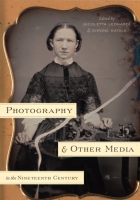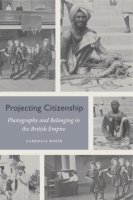Disillusioned
Victorian Photography and the Discerning Subject
Jordan Bear
“In an impressive and timely counterpoint to recent emphasis on the archival appropriations of photography, Jordan Bear turns conventional assumptions about belief in photographic realism on their head, showing that, throughout the nineteenth century, claims for photographic verisimilitude were greeted with doubt, distrust, disappointment, and even ridicule, opening the way to other photographic practices—and, indeed, as exemplified by Disillusioned, to another history of photographic production and consumption and to important new insights into the historical formation of the discerning liberal subject.”
- Media
- Description
- Reviews
- Bio
- Table of Contents
- Sample Chapters
- Subjects
“In an impressive and timely counterpoint to recent emphasis on the archival appropriations of photography, Jordan Bear turns conventional assumptions about belief in photographic realism on their head, showing that, throughout the nineteenth century, claims for photographic verisimilitude were greeted with doubt, distrust, disappointment, and even ridicule, opening the way to other photographic practices—and, indeed, as exemplified by Disillusioned, to another history of photographic production and consumption and to important new insights into the historical formation of the discerning liberal subject.”
“Jordan Bear presents nineteenth-century British photography as an epistemological problem, bearing on questions of reality and how it should be represented. These are social and political questions as much as cultural ones, and the great strength of Bear’s book is his insistence on the inseparability of these terms. Anyone interested in the history of photography will want to read his account and measure it against the way these same terms are being negotiated in our own time.”
“Disillusioned will take up a useful place alongside studies like Michael Leja’s Looking Askance: Skepticism and American Art from Eakins to Duchamp—scholarship that shifts the art historical priority from production to the active, creative, and socially generative processes of what used to be called mere ‘reception.’”
“Historically rich, theoretically sophisticated, critically informed, and modest even as it shifts the grounds of critical consensus about a number of key questions about photography. It is quite simply a tour de force.”
Jordan Bear is Assistant Professor of Art History at the University of Toronto.
Contents
List of Illustrations
Acknowledgments
Introduction. The History of Photography and the Problem of Knowledge
One. See for Yourself: Visual Discernment and Photography’s Appearance
Two. Shadowy Organization: Combination Photography, Illusion, and Conspiracy
Three. Same Time Tomorrow: Serial Photographs and the Structure of Industrial Vision
Four. Hand in Hand: Gender and Collaboration in Victorian Photography
Five. Signature Style: Francis Frith and the Rise of Corporate Photographic Authorship
Six. Indistinct Relics: Discerning the Origins of Photography
Seven. The Limits of Looking: The Tiny, Distant, and Rapid Subjects of Photography
Conclusion. “Normal” Photography: The Legacy of a History
Notes
Bibliography
Index
Introduction
The History of Photography and the Problem of Knowledge
Writing a history of the idea that “seeing is believing” would doubtless be an impossibly circuitous undertaking, but there would be certain junctures to which the meandering historian’s attention would be quickly drawn. The traditional milestones of mimetic progress would seem the logical guideposts on this journey, as they confront their viewers with the inadequacies of settled representational practices and the structures of knowledge and conviction upon which those practices were predicated. It is tempting to think that excavating the historical specificity of photography’s illusionism would constitute but one more chapter in such an enterprise. This book, however, does not accept the hierarchical premise of that formulation. It begins instead with the observation that the social study of knowledge production, which has assumed a central—if not decisive—role among contemporary human and social scientific enterprises, is to a great extent the product of the same milieux as the images and ideas that will be the focus of this history of photography. It is, as one of the foundational texts of social constructivism reminds us, “from Marx that the sociology of knowledge derived its root proposition—that man’s consciousness is derived from his social being.” The tenet that “knowledge” and “reality” are variables fashioned out of the specific sociohistorical institutions of a society is now almost entirely uncontroversial. It has evolved, much like the objects of its study, into a “given,” a natural state of affairs that is presupposed by the structure of intellectual inquiry. But it is also a historical artifact, whose salient features emerged, perhaps most vividly, in those writings of Marx that were responses to the abortive revolutions of 1848 and the liberalization of private enterprise that followed in Europe, and especially Britain, in the 1850s. The value of this contemporaneity of method and object is not simply a matter of having the proper tools at hand for the materials we will have to shape. Rather, it presents an opportunity to study the history of a particular mode of representation whose contested, variable correspondence to reality reveals among the Victorians a precocious skepticism of the supposed “givenness” of reality itself. It also furnishes the much-needed chance to interrogate the odd persistence of taking for granted the taken-for-granted in the very historical period that has furnished us with the awareness to know better.
At the heart of the project shared by Marx and a sundry cast of acolytes and rivals is the apportionment of agency and its exercise among the liberal state and the individuals who comprised it. What seems like a fairly general—if not immutable—conflict embedded in the structure of societies on closer inspection appears to derive from some quite specific historical features of midcentury political economy. While the nonrevolutions of the 1848 “Springtime of the Peoples” proved to be as fleeting as a summer shower, they had exposed the allegiances of bourgeois moderates and the limits of their democratic intentions. At the center of the emergence of the bourgeoisie as a self-aware—and politically decisive—stratum was its failure to support the foot soldiers of the revolutions. The laboring poor appeared, in the radicality of their demands and the swiftness of their successes across the continent, to constitute a threat greater than the continued sovereignty of all but the most absolutist of old regimes. The glacial democratization of particular zones of political life was one thing, but the genuine destruction of the social order was quite another, and the ascendant bourgeois was increasingly willing to see in the first approach a sufficiently rapid path to his success. In Britain, the lines were drawn most starkly in April, when a mass Chartist demonstration sought to capitalize on the havoc wreaked by weeks of industrial rioting in the north by personally delivering its demands to Parliament. Built up as the decisive confrontation in English political history, the Chartists ultimately managed to recruit only a fraction of the revolutionaries they had hoped to harness. By contrast, the authorities were able to deputize more than ten thousand members of the middle class as special constables, a show of force that compelled the dispersal of the crowd. The humiliation was acute, and the dissolution of the viable revolutionary force on Kennington Common sapped the strength of the movement long enough for the economic boom of the 1850s to set in.
While the structural inequities underlying the unrest remained largely in place, the new prosperity initiated a public culture of “progress” that nurtured the belief in the power of market liberalization to transform the lot of the lower classes, and to grant new freedoms of its own creation. As Eric Hobsbawm has wryly noted, “If Europe had still lived in the era of the baroque princes, it would have been filled with spectacular masques, processions, and operas distributing allegorical representations of economic triumph and industrial progress at the feet of its rulers.” Of course, such “rituals of self-congratulation” as the Great Exhibition of 1851 served effectively as technologically updated pageants, produced on a scale and in an environment that was itself demonstrative of the industrial apotheosis being lauded. The momentum for political liberalization was readily channeled into the opening up of new consumer markets. Indeed, one of the few pieces of genuinely progressive reform legislation in the 1850s came not in the expansion of bread-and-butter political rights, but in the removal of so-called taxes on knowledge, the stamp duties imposed on newspapers, and constituted merely an addition to the menu of available goods. Censorship controls fell in favor of transferring the responsibility of judgment to the consumer: the radical pamphleteer was newly occupied by his morning paper. The era of revolution had in short order become the epoch of leisure.
It is telling that this new zone of recreation was described by one Victorian authority as “a sort of neutral ground,” a characterization in close accord with the rather extreme form of laissez-faire economic policies feeding the boom. As Peter Bailey has argued, leisure comprised “a cultural void and placed alarming new responsibilities upon the individual’s capacity for self-direction.” The range of possibilities available to the consumer of recreation, and the relatively unfettered freedom of choice accorded to him, posed a predicament to the dominant bourgeois culture. Matthew Browne, a commentator suspicious of this newly granted liberty lamented, typically, that “free trade, free religion, free art and free self-culture are all bound up in the same bundle and stand or fall together.”
This bundle seemed to be tautly tied together in that decisive “handbook of mid-Victorian liberalism”: John Stuart Mill’s Principles of Political Economy (1848). In what would become the guiding axiom for the political thought of the two decades following the treatise’s publication in that year of continental revolutions, Mill averred that “laisser-faire, in short, should be the general practice: every departure from it, unless required by some great good, is a certain evil.” The figure who was the beneficiary of this practice was the individual, the preeminent social unit at the core of Mill’s liberalism. That individual’s ability to make a go of it in the worlds of commerce and of ideas, unimpeded by the dictates of higher authorities, was the only route to the improvement of society as a whole. But the meddlesome state would never be far away, and it is for this reason that, Mill declares, “there never was more necessity for surrounding individual independence of thought, speech and conduct, with the most powerful defences.”
The individual had to assert his preeminence not only in the realm of recreation—that is, of pleasure—but also in the darker environs of pain. In his important early essay “Civilization,” Mill discusses the political and moral perils of abrogating one’s visual capacities to witness the display of pain and suffering to the bureaucratic structures of the state. In modern Britain, “all those necessary portions of the business of society which oblige any person to be the immediate agent or ocular witness of the infliction of pain, are delegated by common consent to peculiar and narrow classes; to the judge, the soldier, the surgeon, the butcher, and the executioner.” As a result, Mill avers, “a moral effeminacy, an inaptitude for every kind of struggle” has left men unable to “do what is painful or disagreeable,” because the “spectacle, and even the very idea, of pain, is kept more out of the sight of those classes who enjoy in their fulness the benefits of civilization.” The attenuation of this sensory prowess rendered individuals morally and politically inert, incapable of asserting their necessary position at the heart of liberal society. For Mill, this diminution of visual agency constituted a direct threat to the advancement of that society, for it is “originality of mind and individuality of character, which are the only source of any real progress.”
Visual capacities came to stand, in Mill’s thought, for the empowerment of the individual and the restraint of the state as necessary conditions for “real progress.” The liberal vision was forcefully countered by Marx, who viewed the bifurcated allegiances between self and society in an antithetical way. Yet this appraisal, too, invested the figure of the discerning viewer with the most momentous status. Marx asserted that “where the political state has attained to its full development, man leads, not only in thought, but in reality, in life, a double existence . . . he lives in the political community, where he regards himself as a communal being, and in civil society where he acts simply as a private individual, treats other men as means.” In an inversion of Mill’s schema, this state promises to alleviate the alienation of the individual by integrating him into its community, but demands of him the cutthroat individualism at the heart of the capitalist expansion. Yet, along with Mill, the liberation of the senses is critical in Marx’s account, their release linked not to economic liberalization but to the destruction of capitalism, for “the transcendence of private property” would require “the complete emancipation of all human senses and qualities. . . . Only through the objectively unfolded richness of man’s essential being is the richness of subjective human sensibility (a musical ear, an eye for beauty of form—in short senses capable of human gratifications, senses conforming themselves as essential powers of man) either cultivated or brought into being.” Here Marx implies that it is society’s obsession with private wealth at the expense of communal welfare that has retarded the sensory apparatus by its atmospheric brutality: “Every organ of sense is injured in an equal degree by artificial elevation of temperature, by the dust-laden atmosphere, by the deafening noise.” These capacities are to be won back only by drastic measures, and their refinement will be crucial to the larger political enterprise of dispelling the ideological bases of capital’s dominance. The apotheosis of this procedure would be the keen awareness of ideology’s deceptions, which Marx articulated in a well-known visual metaphor: “[I]f in all ideology men and their circumstances appear upside-down as in a camera obscura, this phenomenon arises just as much from their historical life-process as the inversion of objects on the retina does from their physical life-process.”
Visual discernment was, then, the preferred metaphor in the two most consequential—and antagonistic—politics of the 1850s. Indeed, it became the key for mediating the individual’s agency and his place in the community. This study asserts that a primary feature of the development of modern society was the dramatic expansion of an audience empowered to judge the reliability of its own visual experience. The book tells a number of stories about photography’s role in the formation of liberal subjectivity, and these stories posit accounts of the medium and its authority that are not entirely commensurable with one another. Indeed, it recognizes the full complexities of Victorian society and culture that permitted such wildly divergent interpretive accounts of vision and of photography to coexist despite their utter incompatibility, both with each other and with the discourses in whose service they were simultaneously enlisted. The negotiation of these variegated possibilities for the medium was itself an untidy process, but as I shall show, they are well illuminated by the heuristic of visual discernment and the variable modes of agency that such discernment implied.
The chronological sweep of this book is bounded on either side by conceptual shifts in understanding how human visual capacities relate to the discernment of representations, and what the agential ramifications of those relationships are imagined to be. It commences with an exploration of the dramatic developments in the phase leading up to photography’s industrialization in Britain, principally in the interconnected realms of vision research, visual education, and the marketplace for visual illusion. In particular, I investigate the evolution of visual deception in the years flanking photography’s announcement in 1839, proposing that the milieu into which this supposedly revolutionary medium was inserted was primed not to receive photography as unquestionably objective. Rather, I demonstrate that photography was much more readily located within a vast mosaic of visual discernment in which political, commercial, and pedagogic institutions had disparate, vested interests in photography’s status. The capacity for the visual discrimination of photographic representations emerges as both a criterion for political agency and as a skill to be commodified, developments that depended precisely upon an ambivalence of photography’s representational role. To understand the impact of the photograph in any historical period, we must study the adjacent forms of visual belief with which it variously competes and collaborates. In the nineteenth century, scientific demonstrations, magic shows, and philosophical games repeatedly put the visual credulity of the modern public to the test in ways that shaped, and were shaped by, the reality claims of photography.
By initiating the narrative here, among the competing—and conjoined—endeavors of visual education and deception, I demonstrate how the new medium of photography was enmeshed within a vast visual environment that daily challenged the credulity and judgment of its citizens. By locating photography within this web of visual belief, the project proposes a reinterpretation of the emergence of the medium, in which the very quality that is imagined to have made it unique—its objectivity—is instead understood as a deeply contested feature, whose malleability reflects the ambivalences of conviction and skepticism in the middle of the nineteenth century.
The book then turns to an investigation of the implications of this conceptual ambivalence as refracted through the distinctive photographic practices of a group of the most significant and successful photographers of the 1850s and 1860s. The surrender of photography’s presumptive objectivity was manifested in some very concrete artistic modes, each of which has been incompatible with the orthodox history of photography and, accordingly, has been marginalized as a curiosity. Yet these practices and debates are not simply marginalia in this history, for they elicited fierce disputes among the Victorians themselves about photography as a medium and, more obliquely, about the nature of representing the real. In their negotiation of their audiences, the key commercial photographers, Oscar Gustave Rejlander and Henry Peach Robinson, created images that readily sacrificed the conventional guarantees of photographic realism in order to activate their viewers’ primed capacities for visual discernment.
The first of these two case studies explores the process of composite or “combination” photography, in which an innovative practitioner would bring together a group of details from distinct negatives and unite them into a single representation. In agglomerating these images, the photographer could overcome the temporal and spatial limitations of photographic technologies, but only by sacrificing the ostensible objectivity inherent to the medium. Here I reconstruct the political and economic contexts of the most topical and controversial of all such images, Oscar Gustave Rejlander’s Two Ways of Life (1857), a photograph fundamentally depicting and enacting one pervasive model of Victorian visual epistemology. Made up of more than thirty separate negatives, Rejlander’s photograph presented a timely moral lesson on the priority of industrial efficiency and initiative, and in its form and its motifs encouraged an attendant mode of visuality. This investigation will show how the discernment and revelation of the constructed photograph’s “seams” were implicated in an urgent debate about how the bond between the individual worker and a collective industrial society was to be organized.
This is a portion of the original introduction, edited for use on the web.
Mailing List
Subscribe to our mailing list and be notified about new titles, journals and catalogs.
